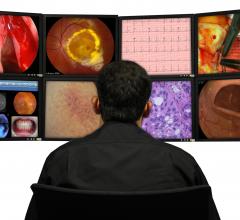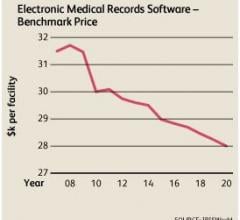
Cardiologists Establish Standard Definitions, EHR Data Elements
January 31, 2013 — The American College of Cardiology (ACC) and the American Heart Association (AHA) released a set of key data elements and definitions for the clinical management of patients with acute coronary syndromes (ACS) and coronary artery disease (CAD). Drafted with the primary goal of aiding data collection, the new standards should ultimately help compare data among different studies, promote the interoperability and applicability of electronic health records (EHRs) and facilitate the adoption of research to clinical practice.
The document was developed as part of a continuing effort of the ACC and AHA to standardize terminology and help improve transfer of health data for research initiatives, clinical registries, structured reporting and use within EHR’s to enhance effective communication among healthcare professionals. The ACCF/AHA Task Force on Clinical Data Standards and collaborating organizations on data standards development have done so with other documents, including those focused on electrophysiology, cardiac imaging, heart failure.
Knowing that caregivers communicate through a specific treatment vocabulary, the ACC and the AHA sought to enhance this communication by standardizing and defining terms. The organizations formed a writing committee of physicians who are experts in the care of ACS and CAD and worked with 13 other medical organizations to develop these key elements and definitions. The team reviewed case report forms, registries, clinical trial data and existing data standards in other areas of cardiovascular care before constructing their own set of standards. Whenever possible, evidence-based national treatment guidelines were linked with the group’s data elements and definitions. In addition, the group coordinated efforts with the U.S. Food and Drug Administration (FDA), which has also developed standardized definitions of major outcomes for clinical trials.
“We hope that these data definitions can advance research and clinical care, to increase the adoption of both proven old therapies and new innovations in cardiology,” said Christopher Cannon, M.D., FACC, chair of the writing committee and cardiologist at Brigham and Women’s Hospital in Boston. “This advancement can support our ultimate goal — to improve outcomes for patients with cardiovascular disease.”
Data elements and definitions were developed in seven categories:
- Demographic and admission — including patient’s sex, date of birth, race, source of admission and payment type.
- History and risk factors — including history of prior angina, previous history of heart failure and date of prior coronary artery bypass grafting.
- Clinical presentation — including the date and time of symptom onset, heart rate, systolic blood pressure on first medical contact, height and weight.
- Diagnostic procedure — including rhythm determined by electrocardiography (ECG), site where first ECG was obtained, LDL value, HDL value and glucose.
- Invasive therapeutic intervention — including type of pacemaker implanted, the date of noninvasive stress testing, the “culprit artery” responsible for the ACS and the percent of stenosis in the left main coronary artery.
- Medication — including the dose of anticoagulant administered, the administration of a beta-blocker in the first 24 hours and the prescription of aspirin at hospital discharge.
- Outcomes — including death during hospitalization, occurrence of reinfarction, surgical intervention required for bleeding and the requirement of transfusion.
When selecting the data elements and definitions, the writing committee worked to create a set that was both complete and functional. “We aimed to keep the list to the key variables, but we still wanted to develop a set that was relatively comprehensive and covered all areas of cardiac care, while also allowing for research of new areas in cardiology,” said Cannon.
The data standards were developed to establish a universal vocabulary that can serve as a solid foundation for both clinical research and clinical care. Specifically, by using consistent definitions across different research studies, the writing committee noted it will be easier to compare outcomes and translate these to improved care practices. This is especially important for meta-analyses of clinical trials and registries, which have been hampered by variations in data collection methods and definitions, the group wrote.
Implementing data elements during charting will also likely ease the move to an electronic health record, the writing committee noted. This is because harmonized, standardized definitions could more easily be exchanged across different health care providers. Furthermore, the use of data standards should facilitate the development of future registries, both at the individual-hospital and national level. Not only would the data elements standardize the assessment of efficacy and safety, they would also establish the key elements needed for developing consistent risk adjustment. Finally, the group stated that standardized definitions should aid quality-improvement efforts by collecting data as part of a quality-improvement program at the hospital, state, or national level, and by identifying underutilized therapies in particular patient populations.
The “2013 ACCF/AHA Key Elements and Data Definitions for Measuring the Clinical Management and Outcomes of Patients with Acute Coronary Syndromes and Coronary Artery Disease” was examined by official reviewers (nominated by the ACC, AHA and the other collaborating medical societies) and underwent a 30-day public comment period. The writing committee plans to periodically review the document, starting with the one-year anniversary of its publication, and update upon the recommendation of the parent task force, the ACCF/AHA Task Force on Clinical Data Standards.
The work of the writing committee was supported exclusively by the ACC, AHA and the other partnering medical organizations without commercial support. All writing committee members were required to disclose industry relationships, which were reviewed by the ACC/AHA Task Force on Clinical Data Standards.
The document is published on the websites of both the ACC and the AHA and will be published in the March 5, 2013 issue of the Journal of the American College of Cardiology (JACC). It is also available on the websites for JACC and AHA’s Circulation.
For more information: www.cardiosource.org/ACC


 August 13, 2019
August 13, 2019 







